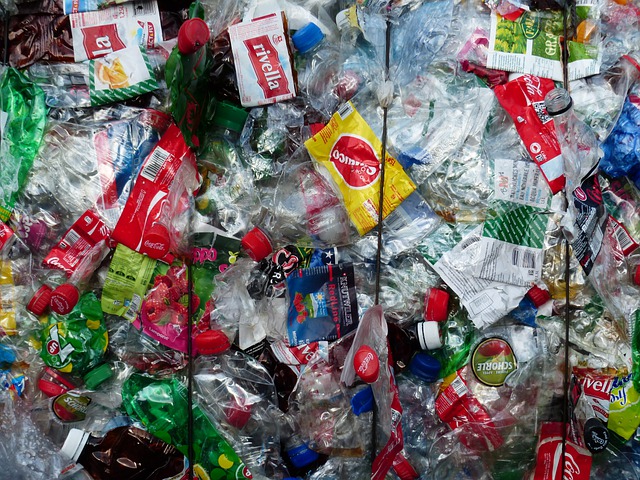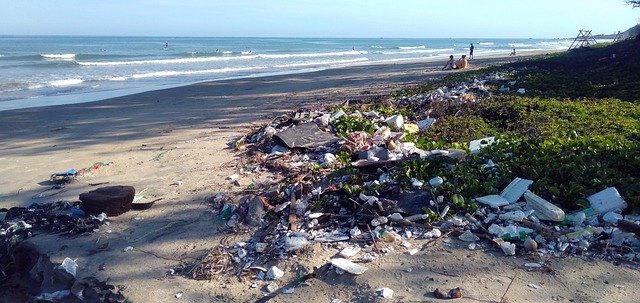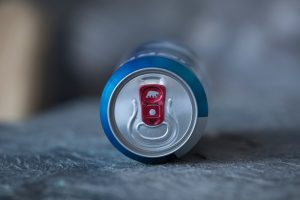The Dangers of Microplastics

Plastics have become ubiquitous in our everyday life. Estimates suggest that we manufacture over 710 billion pounds of plastic per year. To put that in perspective, 710 billion pounds is getting close to the weight of every human being on the planet produced in plastic every year (Worm 2017).
Of this plastic, around 79% is discarded, winding up in landfills or other locations in the natural environment (Geyer 2017). Part of the problem with plastics and plastic pollution is that they do not biodegrade. In other words, plastics don’t decompose, they just break apart into smaller and smaller pieces that persist in the environment.
And plastics disperse in numerous ways. Some plastic waste makes its way into the world’s oceans with estimates suggesting 538 million pounds reside in marine environments (Chaturvedi 2020). Due to water currents, there are five large waste patches where plastic waste accumulates. The most famous of these, the Great Pacific Garbage Patch, is rapidly accumulating additional plastic and spans an area of 620 thousand square miles (1.6 million square kilometers) (Lebreton 2018).
While only recently investigated, preliminary data suggests that a large amount of plastic also breaks down into fibers that are transported through the atmosphere. A study on atmospheric plastic fibers in France concluded that between three and ten tons of plastic fiber waste falls on Paris and the surrounding urbanized areas every year (Dris 2016). A recent study even found that atmospheric plastic fibers were present in a pristine mountain catchment (Allen 2019). It’s likely that virtually nowhere on the planet is devoid of plastic pollution and the problem continues to grow as plastic production continues to increase.
Human Exposure to Microplastics
Humans are exposed to microplastics in three main ways, through oral consumption, from breathing them in and topical skin exposure. Microplastics are found in drinking water, table salt, seafood, fruits, vegetables, cosmetics, personal care products and other sources.
Oral Consumption of Microplastics
Drinking Water
Many plastics float and are easily carried by water. While more studies are needed, the available research shows that both tap water and bottled water contain microplastics (Koelmans 2019). In general, bottled water has more microplastics than tap water with plastic particles numbering in the thousands to tens-of-thousands per cubic meter of water. For bottled water, this works out to at least 3-4 plastic particles per liter, with some sources containing considerably more. Estimates suggest an average annual exposure of up to 4700 microplastic particles per year from drinking water, although estimates for drinking some types of bottled water have reached as high as 90,000 particles per year (Zhang 2020, Cox 2019).
Table Salt
Another surprisingly large source of plastic microparticle exposure comes from table salt. Salt is produced from seawater, rock salt or lake salt. Sea salt had higher plastic particle counts, likely due to ocean contamination. Table salt consumption is thought to contribute up to 74,000 plastic microparticles to the average individual’s diet per year (Zhang 2020).
Honey and Sugar
Along with salt, both honey and sugar also appear to be a larger source of microplastic ingestion. Considering average sugar consumption per year in the United States, Individuals likely consume up to 5600 microparticles of plastic from sugar every year in the U.S. (Conesa 2022).
Seafood
Another common source of microplastics is seafood. One study on commercially available mussels and oysters estimated that the average European consumer could be exposed to 11,000 microplastic particles through mussel and oyster consumption per year (Cauwenbergh 2014). While fish accumulate microplastics, most of the plastic is thought to be sequestered in the digestive tract which is not often consumed (Sequeira 2020). However, definitive research is lacking on levels in other fish tissues. As such, the actual amount of plastic microparticles from fish consumption is unknown.
Fruit and Vegetables
While the extent of exposure to plastic microparticles in produce is not well quantified, the current research clearly establishes that plants uptake plastic particles from the soil and that they appear to lodge in different plant parts, including leaves, fruits, flowers and roots (Azeem 2021). Plants are often exposed to plastic microparticles from farming practices, irrigation systems, water contamination and atmospheric spread.
A study out of Italy raises large concerns and needs replication. The researchers found a median of 97,800 particles per gram in vegetables and 223,000 particles per gram in fruits. These numbers are so much higher than other sources of microplastics that some form of confirmation is needed to verify their accuracy. Regardless, it is likely that fruits and vegetables are a source of microplastic exposure.
Plastic Tea Bags
Of all the potential sources of exposure to microplastics, plastic tea bags are likely a significant source. In one study, researchers found that plastic tea bags released 14.7 billion micro (and nano) particles of plastic into a single cup of tea (Hernandez 2019).
While these results have been challenged by a separate research group, they still found microparticles at levels between 5800 and 20,000 per cup of tea (Busse 2020). Either way, plastic tea bags appear to be a large source of potential exposure to plastic microparticles that could easily dwarf other sources with regular plastic tea bag use.
Inhaled Microplastics
Beyond the consumption of microplastics in the food we eat and the water we drink, we also take in microplastics in the air we breathe. And while research outlined above already establishes that plastic microparticles are found in outdoor air, research suggests they are found within our homes in even larger quantities. One study found that outdoor air had between 0.3 and 1.5 plastic particles per cubic meter. Indoor air ranged from 1 to 60 particles per cubic meter. Home dust had concentrated plastic fibers with 190 to 670 fibers per milligram of house dust (Dris 2017).
Inhaled plastic fibers likely accumulate in the lung and do not appear to break down easily over time (Law 1990). While not well understood, plastic microparticles have been found in lung tissue samples and appear to be present in higher quantities in cancerous lung tumors (Chen 2022).
Estimates suggest that inhalation of airborne plastic microparticles is a significant contributing factor to microparticle exposure. Inhalation likely contributes between 35,000 and 69,000 microparticles of plastic consumed per year (Cox 2019).
Topical Microplastics
Another major source of microplastic exposure and pollution is personal care products and cosmetics. A study out of China found that 70% of personal care and cosmetic products contained microplastics as microbeads (Bashir 2021). Levels of microplastics in cosmetics can reach upwards of 50,000 microparticles per gram (Guerranti 2019). These readily transfer to the environment, further adding to microplastic pollution.
Potential Harms From Microplastic Exposure

Understanding the potential harms from microplastic exposure is extremely complicated and the research on the subject is still in its infancy. Exposure to microplastics is cumulative, building up in the body over time since plastics do not readily break down. Different types of plastic exist and likely have different effects. The shape and size of microparticles, from threads to particles also plays a role in toxicity. In addition, microplastic often acts as a sponge, concentrating other chemicals, toxic substances and even infectious microbes, which all have their own negative health effects separate from microplastics. As such, our understanding is still growing as to potential harms.
In general, microplastics cause increased free radicals (oxidative stress) and inflammation. The free radicals come from chemicals released from the particles or the body’s own immune response. Since microplastics do not break down, this increased inflammation can become chronic which may increase the risks for cancer. Plastic particles have also been shown to be taken up by some cells (Geiser 2005) which can disrupt or even kill the cell (Furukuma 2016).
Reproductive Harm
A study in rats found potential reproductive harm from microplastic exposure with detrimental effects on hormone levels (Amereh 2020). Other studies in mice have also found lowered sperm quality from microplastic exposure with concerns raised over potential effects on male human fertility (D’angelo 2021).
Heart Toxicity
A separate study in rats found that microplastic exposure caused significant heart damage, killing heart cells directly and inducing other cellular stressors causing potential scarring of the heart muscle (Li 2020).
Brain Toxicity
Fish are known to be exposed to microplastics due to the amount of plastic pollution in the oceans. Studies in fish have consistently demonstrated toxic effects to the brain (Kim 2021). In mammals, research is mostly lacking, although one study on rats failed to find significant behavioral alterations after microplastic exposure (Rafiee 2018).
Increased Chemical, Metal and Radioactive Particle Exposure
Microplastics also accumulate and release other chemicals and metals. Bisphenol A (BPA), phthalates, flame retardants, triclosan (an antimicrobial), and organotin (tin-based compounds) are commonly found with microplastics along with other chemicals (Rahman 2021). Microplastics also accumulate heavy metals which could increase exposures if ingested (Rahman 2021). There’s even initial data suggesting that microplastics may concentrate radioactive particles, raising concerns for increased exposure to radioactive compounds (Ioannidis 2022, Johansen 2018)
Infectious Diseases
Microplastics accumulate and concentrate infectious organisms from the environment. A recent analysis found that important and concerning fungal pathogens can accumulate on plastic microparticles which could facilitate the infection of human beings (Gkoutselis 2021). Antibiotic resistant bacteria have also been found to accumulate on microplastics with levels 100-500 times higher than those found directly in water (Zhang 2020). And not to be left out, microplastics effectively adsorb viruses, potentially increasing their infectivity as well (Lu 2022).
Conclusion
While there are huge knowledge gaps and the research is still quite early, what we know so far about microplastic pollution should start to raise alarm bells. Considering the amount of plastic we continue to produce and the amount already in the environment, the long-term consequences of plastic pollution could easily become a massive concern. More research is desperately needed to better understand potential health effects and how to clean up contaminated environments. It’s also worth recognizing that after exposure, we currently don’t appear to have any effective treatment to remove plastic microparticles once they are lodged in the human body. Exposure to plastic microparticles is likely cumulative, building up over an individual’s lifetime.
Hopefully, as more people become educated on the issue, more resources can be dedicated to finding novel solutions. Based on the scope of the problem, it will likely need a dedicated approach worldwide to be effective.



